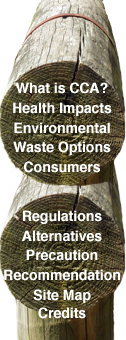Regulations
Australia - Other Regulations
![]() Australian
and NZ Environment and Conservation Council
Australian
and NZ Environment and Conservation Council
![]() The
National Environment Protection and Heritage Waste Working Group
The
National Environment Protection and Heritage Waste Working Group
![]() State
Regulations
State
Regulations
![]() References
References
Australian and NZ Environment and Conservation Council
ANZECC has produced Australian Guidelines for Copper Chrome Arsenate Timber Preservation Plants in 1996.
The National Environment Protection and Heritage Waste Working Group
The EPHC have been asked to consider a national approach to CCA-treated timber waste (NSW EPA (2003b). In a 2002 meeting, it acknowledged the economic importance of arsenic-based timber treatments, but also acknowledged the scientific and community concerns about impacts, the need to prevent harm, and the international trend to precautionary regulation (Scott, 2004).
NSW and Queensland have their own state regulations for CCA treated timber. In NSW, CCA-treated timber is registered for use under the Timber Marketing Act 1977, while the CCA chemical is regulated under the Pesticides Act 1999. Wood Preservation treatment plants must hold an environment protection licence, and are regulated in NSW under the Protection of the Environment (Operations) Act 1997 (NSW EPA, 2003b; NSW EPA, 2003c).
The NSW Department of Environment and Conservation (DEC - incorporating the EPA) has identified CCA-treated timber as a ‘waste of concern’ that is suited to the extended producer responsibility scheme but it has not extended that producer responsibility to it yet as it is awaiting the APVMA recommendations. CCA-treated waste from the National Parks and Wildlife Service and the Botanic Gardens is send to solid waste landfills that have a leachate collection system (NSW DEC, 2004a: 11).
As it has been deemed a ‘secondary priority’ as a waste of concern, the Expert Reference Group will meet with the timber industry and then decide on a course of action, to be determined by mid-2005. (As noted in the section on waste options, Victoria is delaying action on treated timber waste till 2009/10.) The options being considered in NSW are:
- to track the industry and keep a watching brief,
- to upgrade the waste to a priority waste (which then requires industry to take steps towards meeting EPR requirements within 12 months), or
- to drop the waste from consideration (although this is unlikely).
The EPR framework encourages industry to undertake voluntary action in order to seek waste solutions, but under the Waste Avoidance and Resource Recovery Act (NSW), the Minister has the power to legislate if industry fails to adequately address the issue, and if the national initiatives recommended by the APVMA are not effective in NSW. This is supposed to put additional pressure on industry act voluntarily. (Young, A., Director, Extended Producer Responsibility Framework, NSW Department of Environment and Conservation, Pers. Comm., 29/11/04).
![]() Standards
Australia
Standards
Australia
![]() Australian
Pesticides and Veterinary Medicines Authority (APVMA)
Australian
Pesticides and Veterinary Medicines Authority (APVMA)
NSW EPA (2004a), Environmental Compliance Report: Wood Preservation Industry: Part C, Final Report, NSW Environment Protection Authority, December.
NSW DEC (2004b), Extended Producer Responsibility Priority Statement, NSW Department of Environment and Conservation, http://www.epa.nsw.gov.au/resources/eprps2004.pdf (accessed 22/11/04).
NSW EPA (2003a), Environmental Compliance Report- Wood Preservation Industry: Part A, Compliance Audit, NSW Environment Protection Authority, June.
NSW EPA (2003b), Environmental Compliance Report- Wood Preservation Industry: Part B: Review of Best Practice and Regulation, NSW Environment Protection Authority, June)
NSW EPA (2003c), Questions and answers on the wood preservation industry, NSW Environmental Protection Authority website, http://www.environment.nsw.gov.au/licensing/qaswood.htm (accessed 1/11/04).
Scott, G. (2004), ‘CCA Treated Timber: A Problem?’, WMAA Towards Zero Waste Conference, Australia, April.


